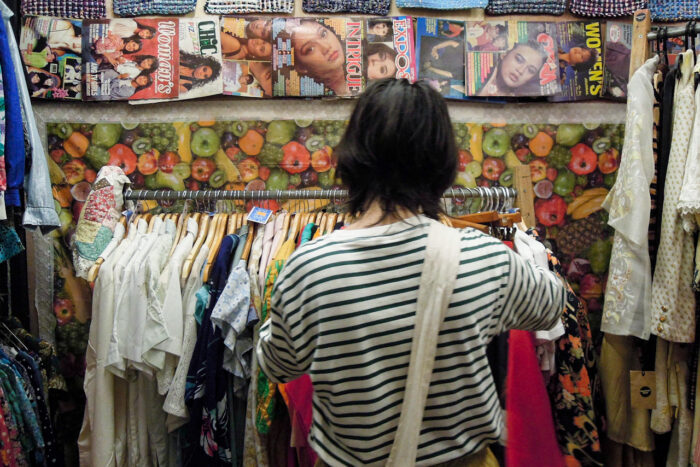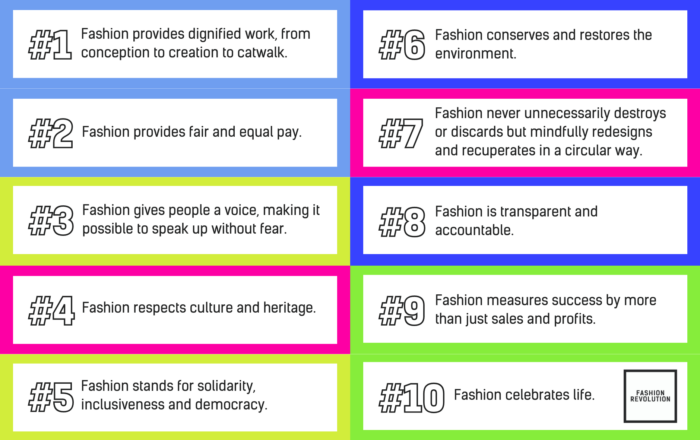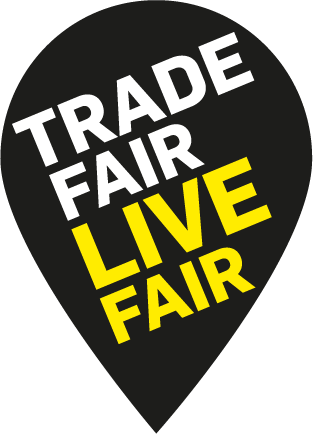Off Paper: The Hidden Cost of Home-based Workers
By: Aastha Jain , member of Fashion Revolution India
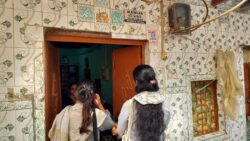 No Policies, No Records—42 million home-based workers remain systematically invisible, with approximately 19% engaged in apparel production. As a policy researcher with the Fashion Transparency Index Working Group between September 2024 and December 2024, I met several women stitching buttons and embroidering and overturning socks in Delhi’s dense colonies, revealing the mechanisms through which capitalist structures perpetuate exploitation, transforming homes into sites of economic negotiation.
No Policies, No Records—42 million home-based workers remain systematically invisible, with approximately 19% engaged in apparel production. As a policy researcher with the Fashion Transparency Index Working Group between September 2024 and December 2024, I met several women stitching buttons and embroidering and overturning socks in Delhi’s dense colonies, revealing the mechanisms through which capitalist structures perpetuate exploitation, transforming homes into sites of economic negotiation.
The informal sector has three archetypes: contractors, piece-rate workers, and self-employed workers. Their labour encompasses completing semi-finished apparel and accessories like bags, shoes, cushion covers, and bangles, assembling bindi packets, attaching buttons, applying trims, packaging, labeling, embroidery, and crochet.
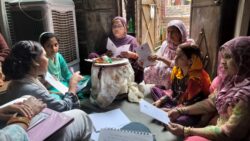 Fixed contractors connected to factories function as intermediaries who distribute work daily or weekly in different neighborhoods. Factories dictate compensation for the contractors. The contractors extract a 40-50% margin before redistributing wages. Piece rates demonstrate huge variability, fluctuating based on geographical location, distance from factories, labour demand, and skills scarcity—ranging from INR 1 ($0.012) to INR 70 ($0.83) per piece. The COVID-19 pandemic exacerbated existing vulnerabilities. Unlike other sectors experiencing recovery post-pandemic, this trade witnessed a wage decline. Contractors, who also tend to be migrant workers, often run away with the due amount. Those who stay nearby or in the same neighborhood as workers show cooperation and timely payment.
Fixed contractors connected to factories function as intermediaries who distribute work daily or weekly in different neighborhoods. Factories dictate compensation for the contractors. The contractors extract a 40-50% margin before redistributing wages. Piece rates demonstrate huge variability, fluctuating based on geographical location, distance from factories, labour demand, and skills scarcity—ranging from INR 1 ($0.012) to INR 70 ($0.83) per piece. The COVID-19 pandemic exacerbated existing vulnerabilities. Unlike other sectors experiencing recovery post-pandemic, this trade witnessed a wage decline. Contractors, who also tend to be migrant workers, often run away with the due amount. Those who stay nearby or in the same neighborhood as workers show cooperation and timely payment.
A shared space for home and work exposes profound gender-based contradictions. Women, responsible for domestic labour, are compelled to negotiate complex frameworks—first fulfilling family responsibilities, then pursuing work in the remaining time. Women decide whether they can accommodate more labour or not as per their domestic schedule. Many women are not allowed to move outside, rendering home-based work as a survival strategy. Work remains fundamentally precarious: no monthly guarantees, with labour oscillating between hectic periods and prolonged intervals of scarcity. The irregularity breeds systemic mistrust and hopelessness, compelling some to abandon this labour mode while others persist as a final economic recourse.
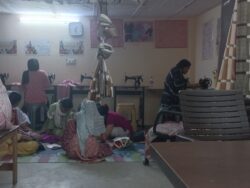 To meet their basic needs, workers try to maximise work, generating low piece-rate wages. Such compensation structures incentivize maximum labour extraction. Families, including children who spend substantial amounts of time with mothers, become integrated into production processes. The fundamental contradiction emerges: how can corporations proclaim freedom from forced or child labour when entire communities are economically coerced into such labour arrangements?
To meet their basic needs, workers try to maximise work, generating low piece-rate wages. Such compensation structures incentivize maximum labour extraction. Families, including children who spend substantial amounts of time with mothers, become integrated into production processes. The fundamental contradiction emerges: how can corporations proclaim freedom from forced or child labour when entire communities are economically coerced into such labour arrangements?
In Delhi, workers inhabit densely populated neighborhoods characterized by open sewage systems, intermittent electricity supply, water scarcity, and inadequate ventilation. Typical living rooms(a 10 x 10 feet space)egregiously contradict International Labour Organization (ILO) conventions mandating workspace requirements. Workers absorb additional economic burdens, including electricity costs, healthcare expenses, and workspace rental, which remain strategically unaccounted for in supply chain calculations.
“Bindi sticking impacts eyesight, back pain, and exposure to chemicals severely. Another such hazard is from clothes made with chemical dyes. During extreme heat in summer, dyes stick to hands causing skin infections. No provision of safety gears, social security schemes, healthcare provisions worsen the worker’s conditions.” – Subadhra Pandey, Representative SEWA in Delhi
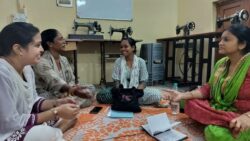 Unionization of informal workers confronts multifaceted obstacles: absence of direct employer contact, lack of governmental protective mechanisms, and the invisibility of home-based labour. Brand identification by workers and the union is impossible within this fragmented production ecosystem. Merely 0.25% of workers comprehend their position within broader supply chains, mentions Subadhra. The proliferation of counterfeit products further obscures potential accountability mechanisms.
Unionization of informal workers confronts multifaceted obstacles: absence of direct employer contact, lack of governmental protective mechanisms, and the invisibility of home-based labour. Brand identification by workers and the union is impossible within this fragmented production ecosystem. Merely 0.25% of workers comprehend their position within broader supply chains, mentions Subadhra. The proliferation of counterfeit products further obscures potential accountability mechanisms.
SEWA is a union of 2.9 million informal workers. SEWA in Delhi serves 70,000 workers out of which 7,000 work in the garment industry as home-based workers. Along with other South Asian organisations, the union has developed a transparency tool called Wage Card to document monthly work and negotiate for fair wages. This tool records transactional details, work performed, payments due, and brand associations.
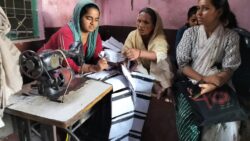 The fundamental struggle demands systemic recognition. Unions articulate comprehensive demands: joint employer responsibility, profit redistribution, social security provisions, regular work, minimum wage guarantees, and most importantly ratification of international labour conventions- C177.
The fundamental struggle demands systemic recognition. Unions articulate comprehensive demands: joint employer responsibility, profit redistribution, social security provisions, regular work, minimum wage guarantees, and most importantly ratification of international labour conventions- C177.
The invisibility of home-based workers reinforces profound epistemic violence—where labour is essential yet systematically marginalized. Most workers do not even acknowledge themselves as workers but as homemakers, wives, or mothers. Their work remains unacknowledged by governments, employers, and manufacturers alike. The hidden costs—including electricity, tools, healthcare, family labor, and unpaid wages—create a perception of cheap production, enabling brands to increase profits by transferring economic burdens to the working class of producing nations.
–
The article is written by Aastha Jain, a visual designer and researcher. She is also a member of Fashion Revolution India. The insights are based on discussions with Subadhra Pandey, Representative SEWA in Delhi, and home-based workers from Delhi. For contact, reach at: aasthajn29@gmail.com
On Paper: Worsening Conditions of Labour in India’s Garment Sector
By: Aastha Jain , member of Fashion Revolution India
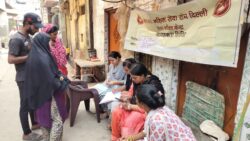
The conditions of workers in producing nations like India reveal a stark contradiction: despite increasing international legislative protections, workers’ lived experiences continue to deteriorate. The acts of intensifying production and alienation of labour have left the workers isolated with stagnant minimum wages and growing monopolization of brands and suppliers. During my time as a policy researcher with the Fashion Transparency Index Working Group between September 2024 and December 2024, I discussed with the union leaders and researchers, the conditions of the garment workers on the shop floor, and the conditions of piece-rate home-based workers in India.
Rukmini VP, President of Garment Labour Union(GLU) highlights that amongst 72 sectors across industries in India, only 4 sectors namely Garment, Leather, Spinning, and Textile have the lowest wages; INR 8,000 ($95) – INR 12,000 ($143) per month (p/m). As per the national law, minimum wages have to be revised every 3-5 years, yet it has stagnated for over a decade in many states. Even if it gets revised its implementation is rare, often retaliated by the factory owners with court cases.
Labour requiring an average of 9 to 11 hours per day (which contradicts Indian Labour Law that limits to 48 hours a week), and paying less than $100 p/m, can increase up to 14 to 16 hours per day during peak seasons.“Workers are allowed a maximum of 30-minute break, and even this is contingent on meeting punishing production targets of 150-200 garment pieces per hour,” says Rukmini VP. Rampant harassment, caste-based discrimination, poor healthcare, and childcare facilities, are further deteriorating the physical, social, and mental conditions of a worker.
“Workers are allowed a maximum of 30-minute break, and even this is contingent on meeting punishing production targets of 150-200 garment pieces per hour,” says Rukmini VP.
The gendered nature of the workforce amplifies these economic challenges. A predominantly female workforce (around 90%) migrates across states to manufacturing districts, being first-generation industrial workers. These migrant workers face heightened risks of harassment, possess weak negotiation power, and experience job insecurity. Underage girls between 14 and 15 years enter factories using falsified age certificates.

In addition to this exploitation which leaves individual workers vulnerable, organising resistance is also made difficult. According to interviewed union representatives, In India, less than 4% of the working class in the garment industry are part of unions. Additionally, they state that the brands, and factories employ extreme forms of tactics to suppress workers from organizing, including targeting the workers, surveillance, economic intimidation, creating yellow trade unions, stopping purchase orders (stop sourcing from that vendor), terminating employment, and threatening organizers, amongst others.
Paradoxically, increasing compliance has created new forms of exploitation. The documentation process has become so complex that specialized firms now solely manage supplier paperwork. Small manufacturers unable to navigate this bureaucratic labyrinth are being systematically eliminated, establishing a monopoly on large manufacturers. The legitimacy of submitted documentation also remains highly non-reflective of the conditions. It remains unreliable due to sole commitment to paper as a tool for auditing. There are no third-party audits or unplanned visits to verify the information shared in the submitted documents. Factory visits are meticulously planned, with workers threatened to maintain silence. The auditors do not engage with the unions who could bear testimony to the true working conditions.

Brands have transferred their responsibility and accountability of ensuring decent working conditions to the suppliers without transferring actual ownership or profits: a sublime act of class manipulation. This paper trail becomes a shield, protecting brands from accountability while maintaining the illusion of ethical production. Workers remain trapped in a system where documentation matters more than real working conditions.
Paper emerges as an instrument of oppression, simultaneously serving as a survival mechanism for the oppressed. Entrenched in their accumulated wealth, the ruling class wields economic instruments, crafting an illusion of autonomy while sharpening the blades of systemic exploitation. Combating global capitalism’s inherent transnational nature, the struggle demands international solidarity. Amidst poor implementation of local state mechanisms, trade unions increasingly rely on global support to negotiate effectively. Their core demands remain fundamental: joint employer responsibility, living wages, union recognition, regular unannounced inspections, and dignified working conditions.
——
The article is written by Aastha Jain, a visual designer and researcher. She is also a member of Fashion Revolution India. The insights are based on discussions with Rukmini VP, Garment Labour Union, Nandita Shivkumar, labour Rights Researcher, and Thivya Rakini, Tamil Nadu Textile Commons Unions. For contact, reach at: aasthajn29@gmail.com
By: So Young Park – Country Coordinator at Fashion Revolution South Korea
We all have old T-shirts with stretched or frayed necklines from countless days of wear and tear. I have clothes tucked away in the back of my wardrobe that I occasionally pull out to reminisce. Volunteering with Fashion Revolution for the past three years has taught me that fashion activism isn’t just about buying clothes with a “sustainable” label. Instead, it’s about digging through your wardrobe, pulling out old clothes, and finding ways to breathe new life into them. I waited until a hole the size of my thumb appeared in a favorite shirt, figured out how to sew it up, covered the hole with thread in my favorite color, and now enjoy the satisfaction of wearing it every time.
My journey into sustainable fashion began in 2020 in a small Batik studio in Jakarta, where I met passionate textile enthusiasts. There, I learned about the craft, history, rituals, and the deep connections between textiles, communities, and respect for nature. This experience profoundly shifted my perspective on life, extending far beyond textiles and fashion. I came to understand that clothing is more than just fabric on our bodies; it represents an ongoing dialogue with the people who make it. It is not something disposable to be taken and thrown away.

In 2021, while traveling through the beautiful landscapes of West Java, I witnessed a polluted river filled with industrial waste and a mountain littered with discarded clothes. It was a shocking sight. My nine-year-old son looked at me and said, “Mum, we have to do something for the planet.” His words stayed with me, and I began searching for ways to make a difference. Together with the dedicated members of Fashion Revolution South Korea, I’ve been volunteering to create digital campaigns that raise awareness about the complex fashion supply chain and its social and environmental impacts. These efforts include an exhibition called ‘Sa-o-ot (Love Clothes Last)’, which highlights the stories of people who have cherished their clothes for years, and translating and distributing the Fashion Transparency Index.
My nine-year-old son looked at me and said, “Mum, we have to do something for the planet.” His words stayed with me, and I began searching for ways to make a difference.

Through translation projects, I’ve met an incredible range of people—fashion designers, students, beauty industry researchers, educational planners, ESG consultants, and others—who have all said that participating in translation and campaign efforts raised their awareness. They expressed that the Fashion Transparency Index helped them understand industry changes and identify areas in need of improvement.
Year after year, the data in the report highlights key issues, revealing both progress and persistent challenges. The fashion industry’s impact varies profoundly across countries, often with devastating consequences. As detailed in the report, fashion can mean vastly different things depending on where you are: from glamorous runway shows to disposable trends that exploit vulnerable communities. In some countries, fashion is tied to women’s rights and freedoms. In others, it’s synonymous with sacrificing children’s education, clean water, and safe working conditions in favor of profits. Each country faces its unique challenges and issues to address within the fashion industry. South Korea, as one of the leading countries in the fashion industry, is no exception to these challenges including the struggles faced by small and medium-sized enterprises (SMEs) due to the weakening of the domestic production base. 
Despite these challenges, there is a universal set of values and directions we must pursue. We must recognize that these issues are not merely obstacles to overcome but opportunities to serve as turning points toward a sustainable future. On Volunteer Day, we honor the countless individuals who dedicate their time and effort to these principles. May their contributions fuel the growth of a just and green transition, paving the way for a more sustainable and equitable future.
Habi Philippine Textile Council (Habi) took a significant step to partner with Fashion Revolution Philippines (Fash Rev PH). They aim to promote sustainable and ethical fashion. They partnered for a series of engaging workshops during the Habi Market Fair. The event took place from October 18th to 20th, 2024, at the Glorietta Activity Center in Makati City. It highlighted the incredible talent of Filipino weavers. The beauty of natural textiles was also showcased. Additionally, the importance of supporting local brands was emphasized.
This partnership marked a first for Fash Rev PH. It merged their passion for ethical fashion with Habi’s dedication to preserving and promoting the heritage of Philippine textiles. The workshops were vibrant with creativity. They offered a unique opportunity for attendees to immerse themselves in the world of weaving. Additionally, they promoted sustainable practices.
The event kicked off with a captivating introduction to the art of weaving, led by Twinkle Ferraren. Participants experienced the joy of creating something with their own hands. This fostered a sense of accomplishment. It also sparked a creative fire within each attendee.
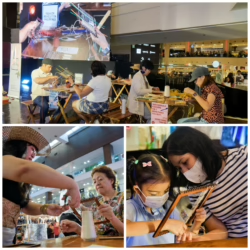
On the second day, Ili Likahaan led a mesmerizing Botanical Eco-printing workshop. Participants discovered the magic of transforming natural textiles using flowers and the rhythmic beat of hammers. This experience was not just about creating beautiful bandannas. It was a journey towards mindful crafting. It also served as a stress-relieving creative outlet.

The final day of the workshops showcased the diverse facets of textile artistry. Hiwaga Hands taught participants the art of visible mending. They used techniques like patchwork, embroidery, and sashiko. These techniques breathe new life into fabrics. Meanwhile, The Art of Yarn introduced children to the world of weaving. They used a small loom. This offered a valuable lesson in the craftsmanship and dedication of local weavers.
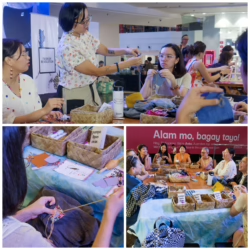
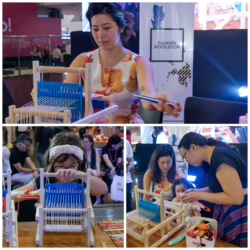
The workshops were a resounding success. Participants gained newfound skills. They also developed a deeper appreciation for the textiles they wear. Additionally, they established a connection to the rich heritage of Filipino weaving. This success demonstrates the power of collaboration. It highlights the growing movement towards conscious consumerism and ethical fashion in the Philippines. The success of this event is a beacon of hope. It inspires others to embrace sustainable fashion choices. It also encourages support for the talented artisans who bring these beautiful textiles to life.
Makati City, Philippines – In a groundbreaking collaboration, Fashion Revolution Philippines, iAcademy, and Lee Jeans Philippines have come together to create a unique and sustainable fashion collection. The project, dubbed “Segunda Mana,” showcases the power of upcycling and the ingenuity of Filipino design students.
A Second Life for Denim
Lee Jeans Philippines donated a trove of old denim stock to iAcademy, challenging the students to transform the materials into a modern streetwear collection. Under the guidance of fashion designer and teacher Irene Grace Subang, the students delved into the art of deconstruction and draping, using Filipino mysticism and superstitions as their inspiration.
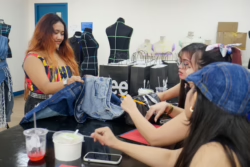
The “Segunda Mana” collection is a testament to the creativity and resourcefulness of the iAcademy students. By working exclusively with upcycled denim, they not only reduced their environmental impact but also created pieces with a unique story to tell. The collection’s intricate designs and thoughtful use of materials showcase the potential of sustainable fashion.
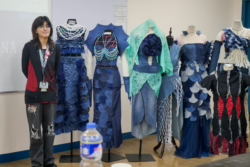
Showcasing Filipino Talent
A portion of the “Segunda Mana” collection was featured during iAcademy’s SODA Week, providing a platform for the students to showcase their work to a wider audience. The event culminated in a fashion show featuring designs from both current and former iAcademy students, highlighting the school’s commitment to nurturing young talent.
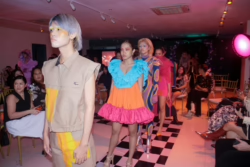
The collaboration between Fashion Revolution Philippines, iAcademy, and Lee Jeans Philippines is a significant step towards promoting sustainable fashion in the Philippines. By demonstrating the possibilities of upcycling and the creativity of Filipino designers, the project has the potential to inspire others to adopt more environmentally conscious practices.
Manila, Philippines – A unique blend of biking, art, and sustainability came together in a recent community event that empowered participants to create their own eco-friendly fashion accessories. The “Bike and Bandana” activity, hosted in Quezon City and Manila, offered a fun-filled day of cycling, eco-printing, and delicious organic treats.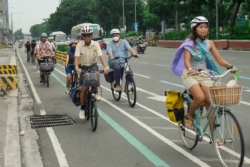 Participants began their journey at Centris Mall in Quezon City, where they embarked on a leisurely bike ride to Dangwa Market in Manila lead by Jeza Rodriguez. The market, known for its abundance of flowers, provided the perfect opportunity for participants to select their favorite blooms for their eco-printing project.
Participants began their journey at Centris Mall in Quezon City, where they embarked on a leisurely bike ride to Dangwa Market in Manila lead by Jeza Rodriguez. The market, known for its abundance of flowers, provided the perfect opportunity for participants to select their favorite blooms for their eco-printing project.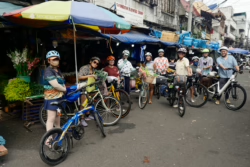 After gathering their floral treasures, the group cycled back to Quezon City and headed to the lagoon in UP Diliman. Here, under the guidance of artist Rosa Mirasol, participants learned the art of eco-printing. Using leaves, flowers, and a hammer, they imprinted their chosen designs onto pieces of linen, creating one-of-a-kind bandanas.
After gathering their floral treasures, the group cycled back to Quezon City and headed to the lagoon in UP Diliman. Here, under the guidance of artist Rosa Mirasol, participants learned the art of eco-printing. Using leaves, flowers, and a hammer, they imprinted their chosen designs onto pieces of linen, creating one-of-a-kind bandanas.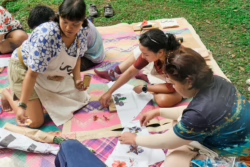 The eco-printing process not only allowed participants to express their creativity but also fostered a deeper connection with nature. By using natural materials and avoiding harmful chemicals, they created sustainable and personalized fashion accessories.
The eco-printing process not only allowed participants to express their creativity but also fostered a deeper connection with nature. By using natural materials and avoiding harmful chemicals, they created sustainable and personalized fashion accessories.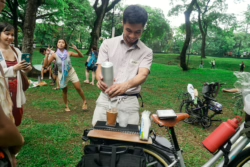 To fuel their creative energy, participants enjoyed a delicious spread of organic delicacies prepared by Lei Azarcon from Luntian Life. Pako salad, pastil, and Geno’s Gabi ice cream were just a few of the delectable treats that delighted taste buds.
To fuel their creative energy, participants enjoyed a delicious spread of organic delicacies prepared by Lei Azarcon from Luntian Life. Pako salad, pastil, and Geno’s Gabi ice cream were just a few of the delectable treats that delighted taste buds.
The “Bike and Bandana” event was a collaborative effort between Make It Safer Movement (MISMo), Bikeary Bicycle Lifestyle, BudolBuddy, and Fashion Revolution Philippines. This partnership brought together like-minded individuals who are passionate about sustainable living, community engagement, and creative expression.
As participants left the event with their newly created bandanas, they not only had a beautiful and unique accessory but also a sense of accomplishment and a deeper appreciation for eco-friendly practices. The “Bike and Bandana” activity was a resounding success, showcasing the power of community, creativity, and sustainability.
On May 19th, 2024, Rizal Park Luneta transformed into a vibrant canvas of culture and eco-consciousness. The National Parks Development Committee (NPDC) joined forces with Fashion Revolution Philippines, SoFA Design Institute, and Urban Sketchers Manila to present a unique Flores de Mayo celebration: Fashionista Flores de Mayo.
This exciting event wasn’t just about religious devotion or showcasing stunning gowns. It was a beautiful fusion of tradition and environmental awareness. SoFA design students presented modern Filipiniana gowns and suits, all crafted with sustainability in mind.
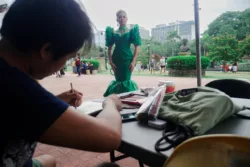 The festivities began at 5:00 pm, with Urban Sketchers Manila capturing the elegance of the “Reinas” (Queens) in their one-of-a-kind attire. As the day unfolded, the Santacruzan parade filled the air with a celebratory energy, snaking its way through the Central Section of Rizal Park.
The festivities began at 5:00 pm, with Urban Sketchers Manila capturing the elegance of the “Reinas” (Queens) in their one-of-a-kind attire. As the day unfolded, the Santacruzan parade filled the air with a celebratory energy, snaking its way through the Central Section of Rizal Park.
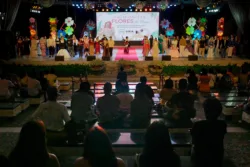
The highlight of the evening was the Santacruzan fashion show, held at the Open-Air Auditorium. Here, the public witnessed a modern interpretation of the Santacruzan tradition, where sustainable fashion took center stage.
But the sustainable fashion movement didn’t end there. From May 21st to 26th, an exhibit titled “Modern Filipin(ian)a: Reimagining Santacruzan Gowns” took place at The Gallery of Rizal Park Luneta. Visitors were invited to get a closer look at the eco-conscious gowns, sparking conversations about responsible fashion choices.
The Fashionista Flores de Mayo was a resounding success. It proved that cultural celebrations and environmental consciousness can go hand in hand, paving the way for a more sustainable future for fashion in the Philippines.
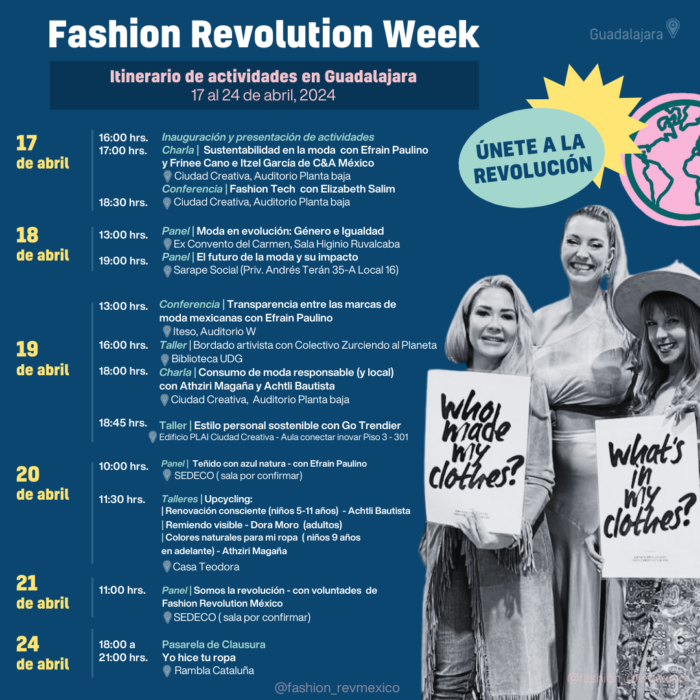 Este 17 al 24 de abril en Guadalajara, Jalisco estará sucediendo algo único!
Este 17 al 24 de abril en Guadalajara, Jalisco estará sucediendo algo único!
Te invitamos a vivir un evento multisede, en el cual podrás conocer de distintas maneras, cómo se puede ser parte de la revolución de la moda, esta de la que tanto se habla y a veces creemos que es totalmente ajena a los que no son diseñadores o marcas de moda.
En este evento conmemorativo por los 10 años de nuestro movimiento, podrás descubrir lo fácil que es ser parte, sin saber nada de diseño o del mundo del fashionismo.
Descubre aquí todas las actividades día por día , y por si quedara alguna duda, puedes seguirnos en Instagram y Facebook, donde estaremos compartiendo todos los detalles de esta increíble semana.
Día 1 – Miércoles 17 de Abril
- Inaguración 4:00 pm
Comenzaremos la semana de actividades con una colaboración irrepetible en Ciudad Creativa Digital:
Además del corte de listón te compartiremos todos los detalles sobre el evento, las sedes, los ponentes y todas las sorpresas que te esperan por ser parte de la Revolución!
- Conferencia: Introducción a la Moda Ética 5:00 pm Una de las marcas pioneras en sustentabilidad en México: C&A, nos acompañará para darnos una introducción a este tema, tan sonado como controversial.
- Conferencia: Fashion Tech 6:30 pm
De la mano de la líder en Tecnologías relacionadas a la sustentabilidad en Jalisco: Elizabeth Salim.
Pregunta por el Auditorio de la planta baja
¡Evento gratuito! ¡Registrate en
Mapa para llegar
Día 2 – Jueves 18 de Abril
Panel: Moda en evolución, género e igualdad 1:00 pm
Nuestros amigos de Igualdad Sustantiva Jalisco nos ayudarán a crear un espacio donde se pueda poner sobre la mesa el cómo la moda tiene una influencia en las nuevas y no tan nuevas perspectivas de género en Jalisco y en el mundo. Y lo mejor, en uno de los recintos mas cool de la Ciudad: el ExConvento del Carmen (pregunta por la Sala Higinio Ruvalcava)
¡Evento gratuito! ¡Registrate en
Mapa para llegar
Panel: El futuro de la moda y su impacto – 7:00 pm
Un grupo de mujeres emprendedoras y pioneras en la Moda sustentable, nos hablarán, desde distintas trincheras, sobre las últimas tendencias y la relación de este tema que tanto suena últimamente con temas como la cultura, el medio ambiente y la circularidad en la zona mas cool de la ciudad a unas cuadras de Avenida Chapultepec!
¡Evento gratuito! ¡Registrate en
Mapa para llegar
Día 3. – Viernes 19 de Abril
Conferencia: Transparencia entre las marcas de moda mexicanas con Efrain Paulino. 1:00pm
El ex coordinador de Fashion Revolution México y experto en Transparencia en la moda, dará la oportunidad a toda la comunidad ITESO para conocer cómo es que se puede ser tener prácticas más transparentes, así como usar eso a su favor en la hora de posicionar y promocionar una marca. Aunque es un evento dentro de la universidad, está abierto a todo Público. No olvides pedir tu QR de acceso al ITESO, enviando tu registro de Event Brite al Instagram de Modas Iteso.
Pregunta por el Auditorio 405 y 406 del Edificio W
¡Evento gratuito! ¡Registrate en
Mapa para llegar
Día 3. – Viernes 19 de Abril
Taller | Bordado artivista con Colectivo Zurciendo al Planeta 4:00pm
Zurciendo el Planeta es una colectiva artivista, que organiza eventos de Activismo ecológico mediante el bordado, y en el marco de nuestra FRW abrirá sus puertas para compartir toda su experiencia e invitar a hacer Artivismo, una actividad clave para ser Revolucionario, así que no te la pierdas!
Será en la terraza del piso 4 de la Biblioteca UDG!
¡Evento gratuito! ¡Registrate en
Mapa para llegar
Día 3. – Viernes 19 de Abril
Charla : Consumo de moda responsable (y local) 6:00pm
Dos mujeres con proyectos que, desde su propia perspectiva profesional sobre la Sustentabilidad: Athziri Magaña de Biosis Lab y Achtli Bautista de Ach+ , nos compartirán el sin fin de posibilidades que existen para que , aún sin ser diseñador ni estudiante de moda, podamos adquirir hábitos y formas de consumir más responsables. Si quieres ahondar en el mundo de la moda Eco, no te la puedes perder!
Pregunta por el Auditorio de la planta baja.
Evento gratuito! ¡Registrate en
Mapa para llegar
Día 3. – Viernes 19 de Abril
Taller : Estilo personal sostenible con Go Trendier – 6:45 pm
Go Trendier! la plataforma número uno de ventas de Segunda Mano, se suma a nuestro cartel de eventos para impartir un taller que te ayudará a construir tu propio guardaropa de una manera más sostenible, entendiendo desde la raíz el concepto de Circularidad y su experiencia como negocio y pioneros en innovación.
Pregunta por el Aula conectar inovar Piso 3 – 301
Evento gratuito! ¡Registrate en
Mapa para llegar
Día 4. – Sábado 20 de Abril
Panel : Teñido con azul natural: alga espirulina- con Efrain Paulino – 10:00 am
El azul es uno de los colores más bellos, sobre todo por que nos recuerda a la tierra, te imaginas teñir la moda con azul natural? cómo, con qué elementos y sobre qué superficies? descúbrelo todo de la mano de este grupo de académicos que están investigando como trabajar con el alga espirulina para encontrar distintas tonalidades de este bello color.
Agradecemos a las Secretarías de Medio ambiente y Desarrollo Económico por darnos este espacio en la colonia más cool del mundo!
(Pregunta por la Sala por confirmar)
Evento gratuito! ¡Registrate en
Mapa para llegar
Día 4. – Sábado 20 de Abril
¡Talleres de Moda Sustentable para toda la famila! – 11:30 am
Upcycling: renovación consciente para niños Enfoque niños 5-9 años acompañados de un adulto. Con Achtli Bautista – Aprende a darle nueva vida a tus prendas en familia y de una manera fácil y circular, desde el toque de una de las marcas de Upcycling más originales en Jalisco: Ach +.
Costo de recuperación de $80 pesos
Remiendo visible – Dora Moro (adultos) de TejeDora – Aprende a bordar y elegir los diseños más adecuados para tus prendas , de la mano de una de las pioneras en arte textil y una talentosísima maestra.
Aportacion voluntaria. Llevar una prenda rota o manchada para reparar con bordado
Colores naturales para mi ropa para adolescentes de Enfoque niños 9 años en adelante, con Athziri Magaña – Conoce formas de teñir tu ropa de la manera más original y sustentable, con elementos naturales que además puedes conseguir fácilmente en nuestro país, de la mano de Athziri, quien trabaja de la mano de artesanas.
Los asistentes deben llevar una playera de algodón que deseen teñir.
Costo de recuperación de $100 pesos
Evento con costo de recuperación
Registrate en
Mapa para llegar
Día 5. – Domingo 21 de Abril
Panel : Somos la revolución – con las voluntades de Fashion Revolution México. – 11:00 am
Conoce nuestro movimiento, y cada paso que hemos dado desde su nacimiento en el sur del país y cómo lo ha ido recorriendo hasta llegar con esta propuesta de evento a Guadalajara, además de conocer qué se viene en un futuro para la moda sustentable en nuestro país!
(Pregunta por la Sala por confirmar)
Evento gratuito! ¡Registrate en
Mapa para llegar
Día 6. – Miércoles 24 de Abril
Pasarela de Clausura: Yo hice tu ropa 6:00 pm
Gracias a Bajío Moda por compartir su filosofía de trabajo, inspirándonos a organizar esta Pasarela al aire libre y de acceso a todo público, justamente para acercar el mensaje de que la moda es para todxs, acompáñanos en la Rambla Cataluña (Av. Juarez en medio de de la rectoría de UDG y el Templo Expiatorio ).
Kuidas astuvad ühte sammu pärandtehnoloogia ja moetööstus? Kui esimese hooga ei oskagi Viljandi Kultuuriakadeemia pärandtehnoloogia konverentsi ja kestliku moe vahel pidepunkte tõmmata, siis tegelikult võib öelda, et meie rõivakandmise juured ulatuvadki kaugele esivanemate aega. Kuidagi on aga läinud nii, et oleme kõigest hoolimata kaotanud oma talupoja mõistuse, seisame silmitsi mõistetega kestlikkus, jätkusuutlikkus ja ringmajandus ning peame endale meenutama, et ka soki augu parandamine on ammu leiutatud jalgratas. Novembris toimunud 11. pärandtehnoloogia konverentsil “Kestlik mood” keskenduti just nendele rohemõistetele, moetööstuses valitsevale olukorrale ning ringi ja ringmajandusega jõuti tagasi ka vana hea talupoja mõistuse juurde. Jagame tähelepanekuid ja tekkinud mõtteid, et selliste konverentside sisu vaid kitsasse ringkonda ei jääks!
Ps! Kultuuriakadeemia korraldatav pärandtehnoloogia konverents toimub iga aasta ning on avatud kõigile huvilistele, tasuta!
Konverents “Kestlik mood” jagunes mõtteliselt kaheks osaks, kus päeva esimeses pooles võtsid sõna Madis Vasser, Krista Kupits, Kadri Kalle ning Diana Tuulik. Ettekannete fookuses olid rohemõisted, seadused, ringmajandus ja materjalid. Päeva teises pooles kõnelesid aga Reet Aus, Stella Runnel ning Kristi Jõeste, kes sujuvalt võtsid arutlusele disainerite-tootjate vaatepunkti, disaini kui sellise ning pärandi rolli moevaldkonnas.
Suures plaanis jõudsid kõik ettekanded sama lõpplahenduseni ehk tarbija vastutab ja “hääletab” tugevalt oma rahakoti ja tarbimisotsustega, keda ja mida ta toetab. Kas halvasti disainitud kiirmoekette või kestlikust silmas pidades, materjale ja pärandit austades loodud rõivaid ja väiksemaid ettevõtteid. Samas olid kõik ettekandjad ka seda meelt, et väikeste muutustega suurte tulemusteni kahjuks ei jõua, suuri muutusi on väga vaja. Ühte suuremat muutust võikski pakkuda 2025. aastal jõustuv Euroopa Liidu tekstiilistrateegia.
Madis Vasseri ettekandest “Miks ei saa muuta nii, et kõik jääks samaks?”, jäid kummitama mitmed küsimused ja tähelepanekud ning ekstra roheline slaid erinevatest märgistest. Praegusaja põhiline küsimus on, “Kuidas saaks edasi minna nii, et majandus kasvaks, aga rohelisemalt?”. Vastu võiks küsida, kas majanduskasv on kõige olulisem ja kas see on ainuke mõõdik, mille järgi heaolu mõõta? Vasser tutvustas erinevaid maailmavaateid ning peamiselt suunda ja mõistet tasaareng (ingl. k degrowth), mis seab kahtluse alla majanduskasvu ülimuslikkuse. Et aga veidigi konverentsi põhiteemale ehk moele lähemale jõuda, tõi Vasser välja ERR-is ilmunud artikli vaesuses elavate inimeste arvu kasvust. Artikli tegi tähelepanuväärseks ilmajäetuse määr, mis “näitab nende isikute osatähtsust, kes ei saa endale võimaldada viit komponenti 13st”. Lihtsalt öeldes, kui inimene ei saa endale neist 13st võimaldada vähemalt viite komponenti, on tegu ilmajäetuse ehk vaesusega. Komponentide hulka kuuluvad ka “6) auto; 7) kulunud või kahjustatud mööbli väljavahetamine; 8) kulunud riiete asendamist uutega”. Kuigi ei saa hukka mõista nende punktide teatavad olulisust, siis kerkib küsimus, kas teiselt ringilt riiete ostmine tähendab, et ma määra järgi ei saa seda endale võimaldada ja olen vaene? Kindlasti mitte. Edukuse ja heaolu mõõdupuuks peab saama miski muu kui majanduskasv, sest viimast taga ajades on raske jõuda moetööstuse kolli rahumeelsema ja rohelisema tuleviku juurde.
Kliimaministeeriumi ringmajanduse osakonna nõunik Krista Kupitsa ettekandes selgus, et kuigi juba eksisteerib seadusi kliima toetuseks, on suureks mureks tõsiasi, et üheski seaduses ei ole defineeritud mõisteid kestlik, säästlik, jätkusuutlik. Nii on tekkinud ettevõtjatele ümberpõige seadustest, sest kui lahti selgitatud pole, saab kehitada õlgu. Kupits selgitas kuulajatele ringmajanduse süsteemi kui sellist, aga tõi ka välja selle komistuskivid, mis tihti saavad ka ettevõtjate vabandusteks, miks ringmajandust ei rakendata. Peamisteks tootjaid takistavateks muredeks on uue infrastruktuuri vajadus, kallim tootmine ning põrkumine globaalsete trendidega ehk jõudmine tarbijani. Tarbija poolelt aga tõi Kupits välja, et tarbijad on mugavad ning muutuste sisseviimine on vaevaline.
Teeme Ära eestvedaja, keskkonnateadlikkuse edendaja ja koolitaja Kadri Kalle vaatles kestliku moe teemat toetudes küsimusele “Mis on tekstiilitööstuse kõige suurem probleem?”. Kui Kalle esitas kuulajatele küsimuse, millises etapis on moetööstuse jäätmeprobleem kõige suurem, kas tootmises, tarbimises või vabanemises, hääletas suurem osa just viimase variandi poolt. Kalle aga tõi välja mõtte, et tootja siiski sõltub oma tarbijatest ning kui tarbimine ei lõppe, ei lõppe ka tootmine. Näitena tõi Kalle ühe ökopuuvillast kandekoti, küsides, kas see on jätkusuutlik valik. Kuigi igasugune adekvaatne ökomärgis (mille tausta ja paikapidavust sa oled varem ka kontrollinud!) on parem valik kui miski muu, siis Kalle järgi on parim valik tarbida olemasolevat ning mitte osta puhtalt märgise pärast. Kalle ettekande märkimisväärseimaks osaks sai aga žest, mida mõni võiks pidada ka ebaviisakaks. Nimelt loobus ta konverentsi ettekandjatele mõeldud meenekotist. Kas sina julgeksid sellises olukorras asjast loobuda?
Materjaliõpetuse lektor Diana Tuulik kõneles kestlikest materjalidest, mis esialgu tekitas kahetisi tundeid, sest kas üldse on olemas materjali, mis on igakülgselt hea. Ettekande kõige intrigeerivam osa oli tekstiilkiudude keskkonnamõju klassifikatsiooni tabel, mis on kõige keskkonnasäästlikumaks lugenud mehhaaniliselt taastöödeldud nailoni ja polüestri, aga jätnud klassifitseerimata (ehk nende materjalide keskkonnasäästlikkuse määramiseks pole piisavalt informatsiooni) villa, naha, mohääri, siidi jm. Kuidas küll plastpudelitest toodetav materjal on saanud kõrgema klassifikatsiooni kui vill? Kas plastpudeleid on vaja toota tekstiili tootmiseks või targem oleks saata pudelid ringlusesse, et neistsamadest pudelitest uuesti pudeleid toota?
Päeva teist poolt alustas Reet Aus ettekandega “Halb disain?”, mõtestades, miks jõudis Keenia prügimäele YSL´i kingake ja kuidas rõivatööstus mõtleb. Ausi põhiline sõnum oli, et rõivaste disainil on toote jätkusuutlikkusele suurem mõju kui me arvame ning rõivatööstuse probleem kui selline saab alguse just halvast disainist. Põnev ja tagantjärgi loogiliselt mõjus Ausi väljatoodud tõsiasi, et tekstiilimaailma ongi hetkel keeruline muuta, sest see on Z-põlvkonna (sünd alates 1997) teenistuses. Selle põlvkonna olemus seisneb aga kallis maitses, õhukeses rahakotis ning mures kliimamuutuste ja looduskatastroofide pärast. Sisuliselt on hetkel kõige suuremaks tarbijaks põlvkond, kes on üheaegselt kliimamuutuste aktsioonide poolt JA kiirmoe tarbijad. Nii ongi pop panna oma tootele rohekleeps peale, sest Gen-Z südametunnistus on kerge, kui ta saab osta märgisega 4€ T-särgi.
Konverentsi lõppu jäid kaks ettekannet, mis eelnevatele mõnusaks kontrastiks rääkisid ka sellest, mis ja kuidas on hästi ehk näiteid Stella Runneli ringmajandavast väikeettevõttest ning Kristi Jõeste maa peale tagasi toov ettekanne pärandist moeloomes. Stella Runneli ettevõte Stella Soomlais toodab ringmajanduslikul põhimõttel nahast käsitööna valmivaid aksessuaare. Runnel tutvustas oma ettevõtte toimimist võrdlemisi detailselt ning nentis, et proovib toota nii, et jääke tekiks vähe. Näiteks tõi ta välja, et ühest nahatükist loodud koti järel tekkis vaid peotäis kasutuskõlbmatuid tükke. Samuti selgitas ta, et ettevõttes käib pidev tootearendus, mis tugineb nii kasutaja kogemustele kui ka sellele, et ettevõte pakub oma kottidele puhastus- ja hooldusteenust. See võimaldab neil päriselt näha, kuidas nende tooted aja jooksul elavad, kuluvad ning mida võiks järgmise mudeli puhul muuta. Samas nentis Runnel, et sellise ettevõtte ning toimisviisini on ta jõudnud tänu korduvatest vigadest õppimisele.
Kristi Jõeste ettekanne kõneles nii Kultuuriakadeemiast välja kasvanud moeshowst “Omamood”, kui ka laiemalt sellest, kuidas Kultuuriakadeemia pärandtehnoloogia õpilased on pärandit taas moodi viimas. Jõeste ettekandest jäi enim kõlama, et talupoja mõistus ei peaks piirduma vaid soki parandamisega vaid võiks laiemalt edasi kanduda rõivadisaini ja oma riiete valimisse ning hooldamisse. Näiteks on Kultuuriakadeemia tudengid loonud oma enda lammaste villast mantleid, mantlite lõigetel võtnud eeskuju vanade eestlaste imeilusatest vammustest, mis täna panevad tänaval möödujaid pead pöörama. Mis puutub aga talupoeglikku suhtumisse oma rõivaste valimisel ja hooldamisel, võiks Jõeste ettekandest noppida mõtte, et rõiva kestlikkus seisneb paljuski ka rõiva emotsionaalses väärtuses. Nii nagu rahvarõivaid on pärandatud põlvest põlve, võiks ka tänapäeval rõivas kandjale olla niivõrd oluline ja armas, et selle eest hoolitsetakse ja seda antakse edasi. Kas sinu riidekapis on mõni selline igikestev ese, mida armastad ja hoiad ning edasi pärandad?
Fashion Revolution Eesti tiimi peamised mõtted ja nopped konverentsilt:
- Majanduskasv ei saa enam harjunud kombel jätkuda. Üks võimalik lahendus on tasaareng, mis mõtestab ümber senise majanduskasvuteooria.
- Ilmajäätuse määr, mis kõneleb sellest ühiskonna osast, kes ei saa endale võimaldada viit komponendi 13st olulisest (mh. kulunud/kahjustunud mööbli väljavahetamine ja kulunud rõivaste asendamine uutega).
- Üheski seaduses ei ole defineeritud mõistest kestlik, säästlik, jätkusuutlik. See loob soodsa pinnase igaühele mõistete tõlgendamiseks endale sobivalt ja tekitab ühiskonnas vaidlusi ja ebakõlasid.
- Mil moel on mehaaniliselt taastöödeldud nailon ja polüester kõige keskkonnasäästlikum valik?
- Tänane ühiskonna ja tarbimiskultuuri muutmise kuldvõti peitub zoomerite taskutes, keda iseloomustab mure kliima pärast ja õhuke rakott.
- Lõplik ringmajanduslik bränd on jõudnud sellesse kohta ainult läbi kolistatud ämbrite.
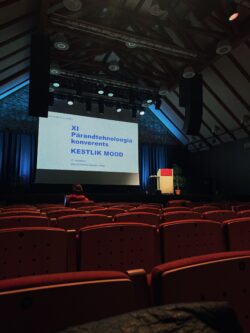
Manila, Philippines – Wine gets better with age and so does clothes where they gets fabulous with decades. That’s what vintage fashion is all about, give second chances to old clothes. The last Sunday of the May held a vintage community flea market where you can grab as many old clothes as you can.
The vintage community flea market ran a one day event on 28th of May 2023 called “Second Chances” at the Escolta street, Manila. The First United Building hosted the Second Chances event at the first floor. Appropriately, the vintage Art Deco building’s first floor housed the popular Berg’s department store before the malls where built. Now, a second chance to relive the popular department where you can wear all the old goodies that you can.
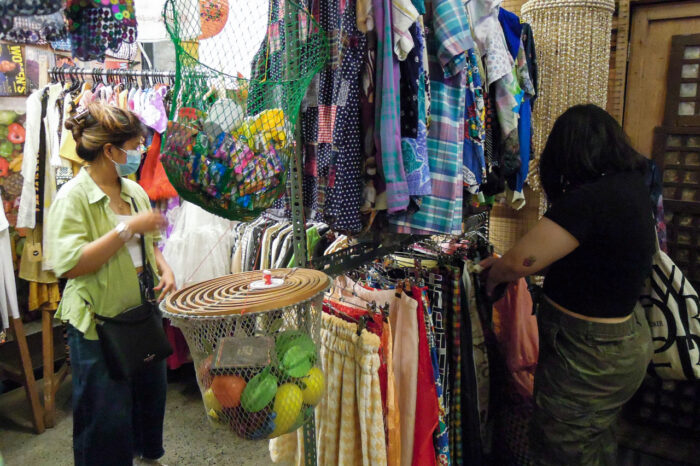
Bring back the good old times
A buffet of the rare, beautiful and luxurious old fashioned clothes from various pop-up stores to vintage vendors. Here you can find Glorious Dias and The Vintage Junkie Manila with pop-up stores Luntian Palamuti Atbp, Wear Kahel, RioTaso, Season Pass and so much more where they help the fashionistas find the those old gorgeous clothes to re-wear them. This vintage community brings back the fashion era from the 1960.
The moment you stepped in you are greeted with an atmosphere from the past. A past that screams with a visual feast of all the vintage clothes with the background music of Manila in the 1960s to 1970s. A fashionista gets drowned with so much choices from clothes to accessories. A feeling of endless creativity and that fashion could never die.
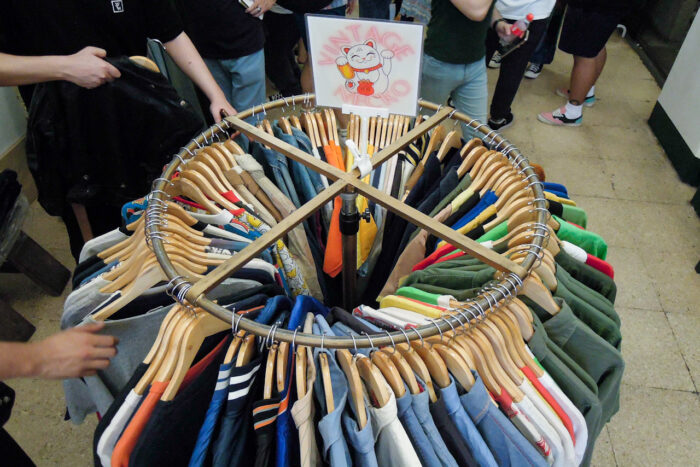
A Fashionista’s dream come true
Jodinand Villaflores Aguillon advocate of upcycled fashion and the owner of Glorious Dias have dreamt of this event for a long time and it finally happened with The Vintage Junkie Manila, Season Pass, Hub Make Lab, Pineapple Lab and The First United Building. A moment where everyone can be on a one stop shop of all vintage as a new fashion or a restyled new trend. People in this event may be unaware that they are already creating an impact. A gesture to buy these old clothes as to repurpose or upcycled already help reduce textile waste that has become one of the major impact to the environment. At the same time, the consumers learned to appreciate these clothes, the people who made them and ourselves. The Second Chances brought such awareness and impact in this small community.
Create a habit of awareness
This one day event created an echo of meaningful gesture. A gesture would hopefully allow modern consumers to understand the value of clothes and the people behind it. An aim to help create a shopper’s habit to spend less and buy smartly on their next fashion items.
Manila, Philippines – The Fashion Revolution Philippines commemorates the victims of the Rana Plaza factory collapse in Bangladesh, in alignment with the Fashion Revolution week held globally. The Rana Plaza factory collapse killed 1,138 textile workers and injured more people became an eye-opener to the world on 24 April 2013. The incident drove the Fashion Revolution movement to push for labor rights transparency and sustainability in the fashion world.
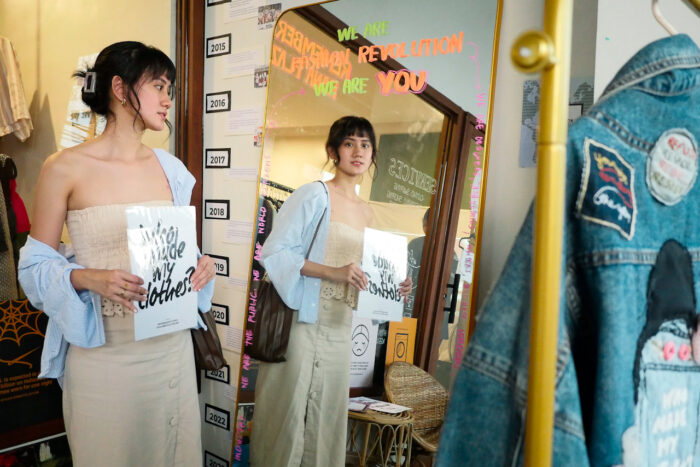
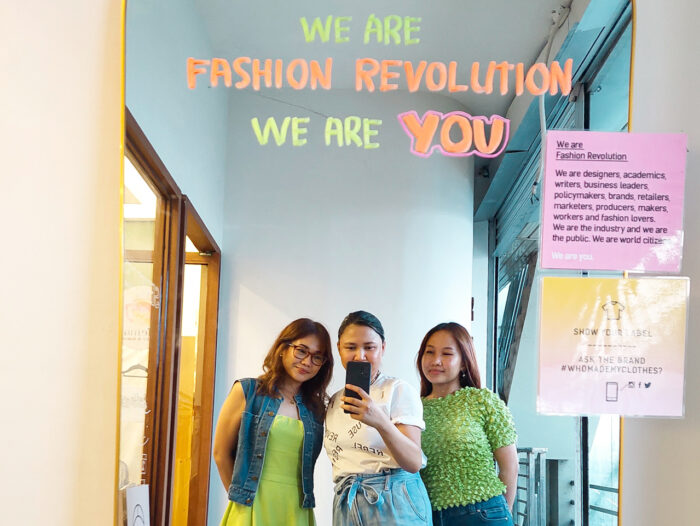
The Fashion Revolution Philippines’ first in-person event held for two days since the pandemic started. The two-day event happened in Moda Laya in commemoration of the 10 anniversary after Rana Plaza disaster. Attendees participated in activities such as clothes swapping, panel discussion with the experts and the screen showing of two documentary films.
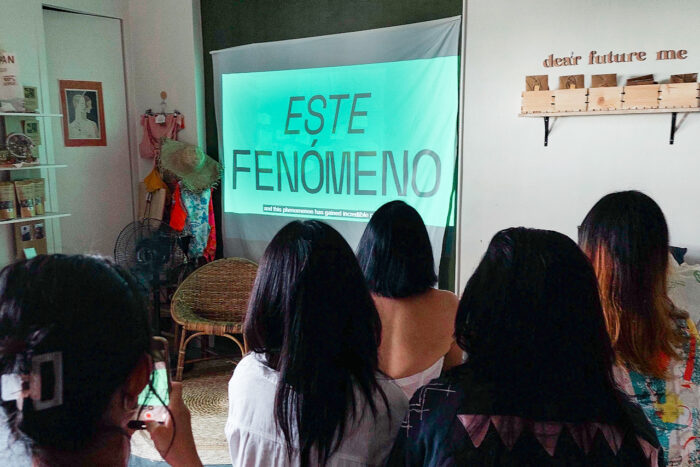
The “Se Abrió Paca,” a film made by the Fashion Revolution Guatemala, gave a heartfelt discussion among its viewers just after it was shown with the “True Costs” documentary and the power outage on the first day. Activities on the next day went well with the clothes swapping and panel discussion. Prince Ventura leads the panel discussion with Bianca Gregorio, owner of Moda Laya and founder of Re-clothing, Irene Subang, sustainable fashion designer and educator, and Jamie Naval, founder and CEO of Twenty Kids and Barrio Studios. Our guest experts discussed that the society today needs to focus on the importance of sustainable practices and a circular wardrobe.
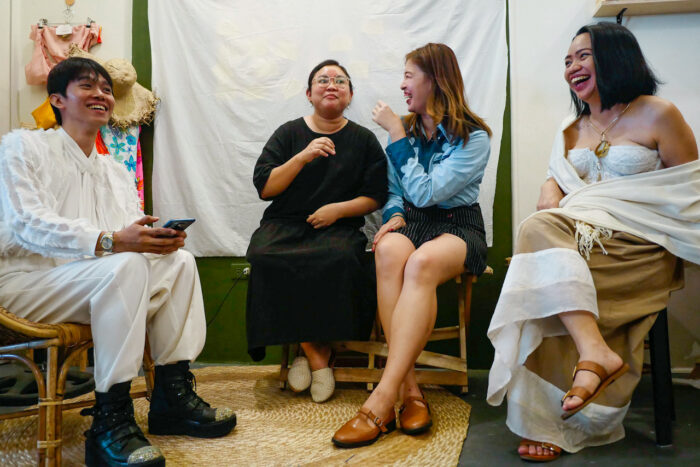
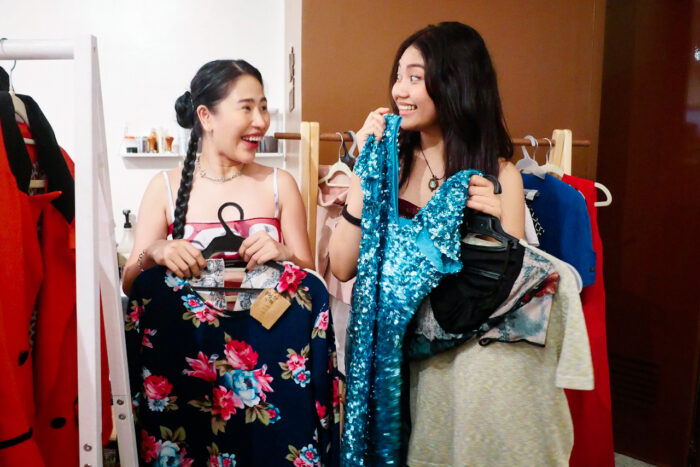
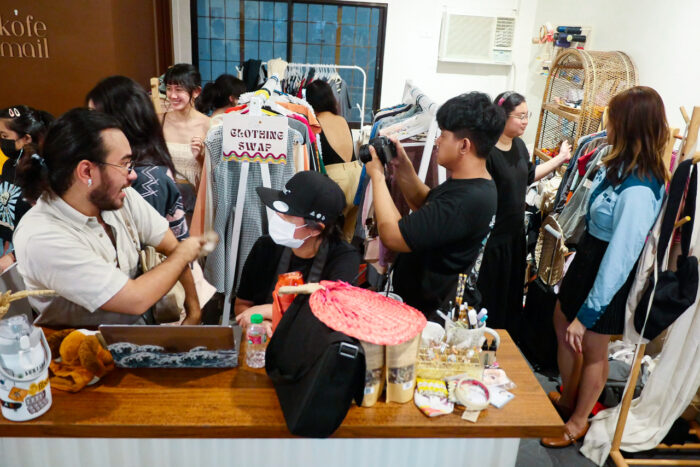
Fashion Revolution Week is our annual campaign bringing together the world’s largest fashion activism movement for seven days of action. It centres around the anniversary of the Rana Plaza factory collapse, which killed around 1,138 people and injured many more on 24 April 2013.
This year, as we marked the tenth anniversary of the Rana Plaza factory collapse, we remembered the victims, survivors and families affected by this preventable tragedy and continue to demand that no one dies for our fashion. To define the next decade of change, we translated our 10-point Manifesto into action for a safe, just and transparent global fashion industry. Our campaign platformed the work of our diverse Global Network who provided local interpretations of their chosen Manifesto point(s). We believe that while fashion has a colossal negative impact, it also has the power and the potential to be a force for change. Together, we expanded the horizons of what fashion could – and should – be.
Here, catch up on some of the week’s highlights and find out how to stay involved with our work, all year round.
Remembering Rana Plaza
Fashion Revolution Week happens every year in the week coinciding with April 24th, the anniversary of the Rana Plaza disaster. On April 24th 2013, the Rana Plaza factory building in Bangladesh collapsed in a preventable tragedy. More than 1,100 people died and another 2,500 were injured, making it the fourth largest industrial disaster in history. On April 24th, we paused all other campaigning to pay our respects to the victims, survivors and families affected by this tragedy, and came together as a global community to remember Rana Plaza.
As we reflect a decade on, we are inspired by and celebrate the progress made in the Bangladesh Ready-made Garment (RMG) sector by the Accord. The International Accord on Fire and Building Safety was the first legally-binding brand agreement on worker health and safety in the fashion industry and is the most important agreement to keep garment workers safe to date. This year, we pay tribute to the joint efforts of all Accord stakeholders who have significantly contributed to safer workplaces for over 2 million garment factory workers in Bangladesh, including the Bangladeshi trade unions representing garment workers, alongside Global Union Federations and labour rights groups. We welcome the introduction of the Pakistan Accord and would like to see the adoption and success of the International Accord replicated in all garment producing countries.
Manifesto for a Fashion Revolution
Our theme for Fashion Revolution Week 2023 was Manifesto for a Fashion Revolution. Back in 2018, we created a 10-point Manifesto that solidifies our vision to a global fashion industry that conserves and restores the environment and values people over growth and profit. This year we called on citizens, brands and makers alike to sign their name in support of turning these demands into a reality, boosting our signature count to 15,500 Fashion Revolutionaries and counting. We are immensely grateful to everyone who has and continues to sign; our power is in our number and each signature strengthens our collective call to revolutionise the fashion industry.
To campaign for systemic change in the fashion industry, we themed the week around complementary Manifesto points, providing ways to be curious, find out and do something daily around each of them. From supply chain transparency to living wages, textile waste to cultural appropriation, freedom of association to biodiversity, we shared global perspectives and solutions to fashion’s most pressing social and environmental problems.
Over the past ten years, the noise around sustainable fashion has only got louder. But meanwhile, real progress is too slow in the context of the climate crisis and rising social injustice. That’s why Fashion Revolution Week 2023 was an action-packed and future-focused campaign that amplified the actions and perspectives of Fashion Revolutionaries around the world.
View this post on Instagram
Global Conversations
To capture these global perspectives, we launched the Fashion Revolution Map on Earth Day, which coincided with the start of Fashion Revolution Week. Developed by Talk Climate Change, the Map served as a global forum to reflect on the week’s themes and events, using our Manifesto as a talking point. Fashion Revolutionaries continued the discussion offline by inviting their family, friends, colleagues and classmates to imagine what a clean, safe, fair, transparent and accountable fashion industry would look like with us. These conversations were then recorded on the Map as a source of inspiration and knowledge exchange.
Anyone can be a Fashion Revolutionary; it starts with a simple dialogue about the changes you want to see in the fashion industry. Make your voice heard by contributing to our map today and help change the fashion industry through the power of conversation!
View this post on Instagram
Good Clothes, Fair Pay Highlights
Ten years on from Rana Plaza, poverty wages remain endemic to the global garment industry. Most of the people who make our clothes still earn poverty wages while fashion brands continue to turn huge profits. At Fashion Revolution, we believe there is no sustainable fashion without fair pay which is why we launched Good Clothes, Fair Pay as part of a wider coalition last July. The Good Clothes Fair Pay campaign demands living wage legislation at EU level for garment workers worldwide, building on Manifesto points 1 and 2.
During Fashion Revolution Week, our EU teams coordinated awareness events, campaigns and marches to mobilise signatures for this campaign. On April 25th, we headed to the European Parliament with Fashion Revolution Belgium to demand better legislation in the fashion industry. The day of action consisted of a panel discussion between Members of the European Parliament and impacted fashion stakeholders, and ended with a stunt outside the Parliament. Fashionably Late highlighted that the EU is running out of time to act on poverty wages in fashion. This stunt was replicated by our teams in Germany, France and the Netherlands throughout Fashion Revolution Week to demonstrate EU-wide solidarity with the people who make our clothes.
We have less than three months left to collect 1 million signatures from EU citizens to push for legislation that requires companies to conduct living wage due diligence in their supply chains, irrespective of where their clothes are made. If you are an EU citizen, sign your name here. If you’re unable to sign, please support the campaign by sharing it far and wide online.
View this post on Instagram
Fashion Revolution Open Studios Highlights
Fashion Revolution Open Studios is Fashion Revolution’s showcasing and mentoring initiative since 2017. Through exhibitions, presentations, talks, and workshops with emerging designers, established trailblazers and major players, we celebrate the people, products and processes behind our clothes.
This Fashion Revolution Week, Fashion Revolution Open Studios joined forces with Small but Perfect to spotlight the work of 28 European SMEs taking part in their circularity accelerator project. Forming part of this European events programme, Fashion Revolution Open Studios held a two-day event in partnership with The Sustainable Angle and xyz.exchange at The Lab E20. The event showcased seven innovative designers from the Small But Perfect cohort of sustainable SMEs and displayed how they are embedding circular solutions into their work, from crafting grape leather handbags to developing community approaches to making and working together. Alongside the exhibition, there were livestreamed webinars, workshops and panel discussions to explore the projects and hear about some of the the challenges facing small businesses and the industry at large in switching to circular business models.
Global Network Highlights
With 75+ teams from all around the world, Fashion Revolution Week 2023 championed the perspectives and contributions of our Global Network. Here are just a small selection of highlights from our country teams:
Fashion Revolution New Zealand unpacked each Manifesto point with industry trailblazers in an Instagram Live series.
Fashion Revolution teams in Bangladesh and Sweden co-organised a virtual panel discussion on shifting consumer behaviour.
Fashion Revolution Singapore celebrated the launch of their digital zine MANIFESTO.
Fashion Revolution teams in Iran and Germany collaborated on Women, Life, Freedom, a joint exhibition.
Fashion Revolution Nigeria shared the stories and journeys of local slow fashion brands.
Fashion Revolution Argentina invited us to join their Wikipedia edit-a-thon.
Fashion Revolution teams in Vietnam, South Africa and Scotland hosted local community clothing swaps.
Fashion Revolution India won the Elle Sustainability Award for Eco-Innovation in Fashion.
Fashion Revolution Uganda brought together the country’s top designers and brands at Kwetu Kwanza.
Fashion Revolution teams in UAE and Canada both held local design competitions for students.
Fashion Revolution Hungary championed the revival of traditional folklore practices in clothing and fashion.
Fashion Revolution USA discussed the fashion industry’s impact on people and planet in a 2-part Zoom series.
Fashion Revolution Uruguay hosted Fashion Celebrates Life, a community picnic themed around Manifesto point 10.
Fashion Revolution teams in Chile and Portugal shared their Fashion Revolution Week highlights with us on Instagram Live.
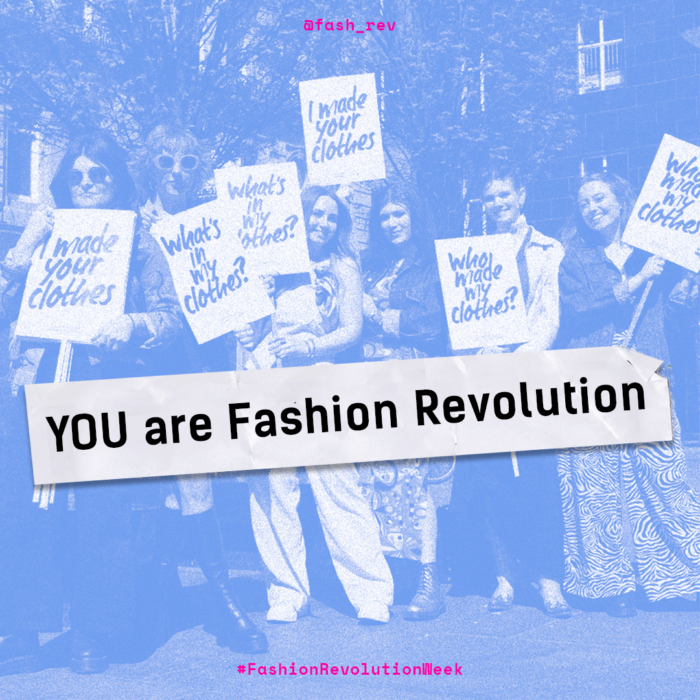
You are Fashion Revolution
We are so grateful to everyone in our community for getting involved in Fashion Revolution Week on social media and beyond. Every single voice makes a difference in our fight for a fashion industry that conserves and restores the environment and values people over growth and profit.
While Fashion Revolution Week 2023 may be over, our community, our campaigning and our movement continues, 365 days a year. Please join us in fighting for systemic change by:
Following us on social media: Stay up-to-date by following us on Instagram, Facebook, Twitter, TikTok, LinkedIn and YouTube, and signing up to our weekly newsletter.
Finding your country team: Connect with the teams in your region by following them online, attending their events and volunteering with them. Find your country team here.
Using our online resources: Our website is a treasure trove of information, from how to guides and online courses to annual reporting on transparency on the fashion industry. Get started here.
From all of us in the Fashion Revolution team, we appreciate your support and we look forward to seeing you next year!

